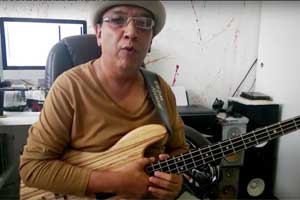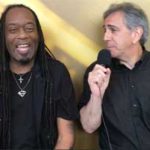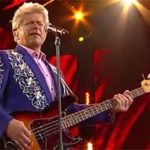Mexican bassist speaks about his prolific career as a performer and session player
By David Sands
October 14, 2015
The soulful bass lines of Pepe Hernández have earned him the nickname “Mr. Groove” in his homeland of Mexico.
You don’t get a name like that without having a masterful command of an instrument, so you better believe he’s has earned every syllable of it. Hernández is a skilled veteran of the Mexican music scene who’s spent three decades honing his craft. His fluency on the bass has made him a sought-after sideman and session artist in Latin jazz, folk and pop circles.
To give you some idea just how prolific Hernández has been in terms of session work, he’s recorded over 500 records over the course of his career—and that’s just counting the non-jazz stuff. Over the years, he’s also toured with some of the biggest names in Mexican music too, folks like José José, Emmanuel and Alejandro Fernández, as well as popular Mexican-American artists like Pepe Aguilar and Vikki Carr.
Beyond this, he’s regarded as an important voice on the Mexican jazz scene and has collaborated with groups like the Enrique Nery Trio, Charlie Hynes Jazz Quintet and The Brooklyn Conservatory Jazz Ensemble. The ubiquitous bassist has also performed in Mexican versions of musical productions like Fame and West Side Story and composed commercial jingles for companies like Nissan and Pepsi.
As you can see, he comes with a rather amazing resume, so FBPO’s Jon Liebman was delighted to be able to speak with Sr. Hernández recently about his musical development, early experiences playing jazz in New York City, equipment and more.
Music has been a central part of Hernández’s life as long as he can remember. He comes from a musical family in the musical city of Acapulco. His father was a professional musician and many of other relatives, including his grandfather who played acoustic bass and drums, were musicians too.
In his youth, Acapulco was quite the resort town, comparable to Las Vegas.
“Every hotel had 5,6,8 bands,” he tells FBPO. “They had mariachi. They had a jazz band. They had a trio band. They had a top 40 band. They had a Latin music band. There was a huge musical scene in Acapulco.”
His home too was filled with a wild mix of different musical styles.
“I grew up listening to Glenn Miller, Benny Goodman, Count Basie, but also Tower of Power, Blood Sweat and Tears, Chicago and also salsa and bolero music,” Hernández says.
Bass was not Hernández’s first musical choice. He actually got his start studying classical guitar at the Conservatorio de Música y Declamación in Puebla, Mexico. However, at the urging of his father, who saw the bass as a more lucrative choice, he switched. With his father as his first instructor, he learned how to play styles like bossa nova and cha cha and would practice with his brother, a talented pianist.
Back then, he was really into jazz and rock bands like Led Zeppelin and Emerson, Lake & Palmer. Due to his father’s insistence, however, he was pushed early on to play Latin music gigs to gain experience as a musician. This required him to play boleros, which he loathed at the time.
“He used to send me to play boleros with this mambo band. There was this cruise in Acapulco every day, a little ship full of gringos,” he says. “And we played mambos and cumbias and dance songs.”
“I used to go crying,” he adds, “Man, I was so ashamed.”
He later grew to like Latin and Mexican folk styles—and to complement his existing musical tastes by listening to artists like Chick Corea, Eddie Palmieri, Stanley Clarke and his bass hero Jaco Pastorius. Hernández would also develop a penchant for R&B and funk, which would help him earn his nickname, Mr. Groove.
As time went on, Hernández continued his musical studies at the Conservatorio Nacional de Música and the Escuela Libre de Música José F. Vázquez in Mexico City. After graduating, he hooked up with a band contracted to play a dinner club called Sirocco in New York City. The bassist stayed there for a year and eight months. During that time he studied double bass with Lev Zagevinzky, a former principal with the Leningrad symphony, and composition with Rick Laird at the Drummers Collective.
While staying in New York, the bassist used to frequent jazz spots like 7th Ave. South, where he got to see musicians he really admired, folks like the Brecker Brothers and Wynton Marsalis.
“When I go to New York, these were the guys who were doing all the records, the important music: Marcus [Miller], Will Lee. Anthony Jackson. And right now, it’s 30 years after, still the same [people making great music].”
Hernández has turned his many years of playing and studying music into very successful career. Over the course of this, he’s had a lot of time to figure out just what gear is right for him.
When it comes to his instruments, he’s really into NS Design basses.
He’s had a NXT-5 upright for the last four years, and recently began relying on the company’s CR-5 models to handle his electric needs. In fact, he says the fretless NS Design bass is the “best-sounding” fretless he’s ever played.
“I happen to love their instruments because they are very versatile, since I record a wide range of styles down here—from rock & roll to a cumbia, to a bolero, to a funk, to a pop song,” he says. “I found that these basses can fit in all kinds of situations.”
For amplification, Hernández depends on an Epifani amp head and Aguilar speakers. He also uses DR strings and loves them. Interestingly, he tunes his five-strings high C, instead of low B.
“I don’t think they were designed for Latin people because we’re not that tall,” he tells FBPO. “Playing is a pleasure. It’s about having fun—being happy, not unhappy, playing and suffering with your hands and fingers.”
Although he’s been a composer for 30 years, Hernández only started releasing his own CDs with his group, the Pepe Hernández Band, in 2008. His debut album Bassico mixes Latin and jazz influences. 2010’s Groove Zone takes Latin and Mexican rhythms and adds funk and R&B to the mix. His more recent recordings Bajo Mundo and Mestizos, similarly explore a range of different styles, including Mexican Huapango and African sounds.
If that sounds all over the map, so are his current efforts.
“I’m working on several projects right now of my own, one with an orchestra—all arena music, one with a big band, one with a Latin orchestra and then my groove project,” he tells FBPO. “I’m also touring [as part of a] very successful tour that is called Tour Amigos. We’ve been on the road for almost two years.”
Asked what might be over the horizon, Hernández muses that he’s played on a lot of great artists’ albums over the years and would like to flip the script.
“I’ve admired for Vinnie Colaiuta for so many years. I want to have him in a record of mine,” he says. “Maybe Mitchel Forman. There’s plenty of musicians that I just love: Michael Landau, maybe Abe Laboriel—invite him to do a duet with me.”




